Catalpa care and growing guide – expert tips for this popular flowering tree
With its white flowers and large leaves, the Indian bean tree makes an excellent feature tree that will create a lasting impression on the people visiting your yard
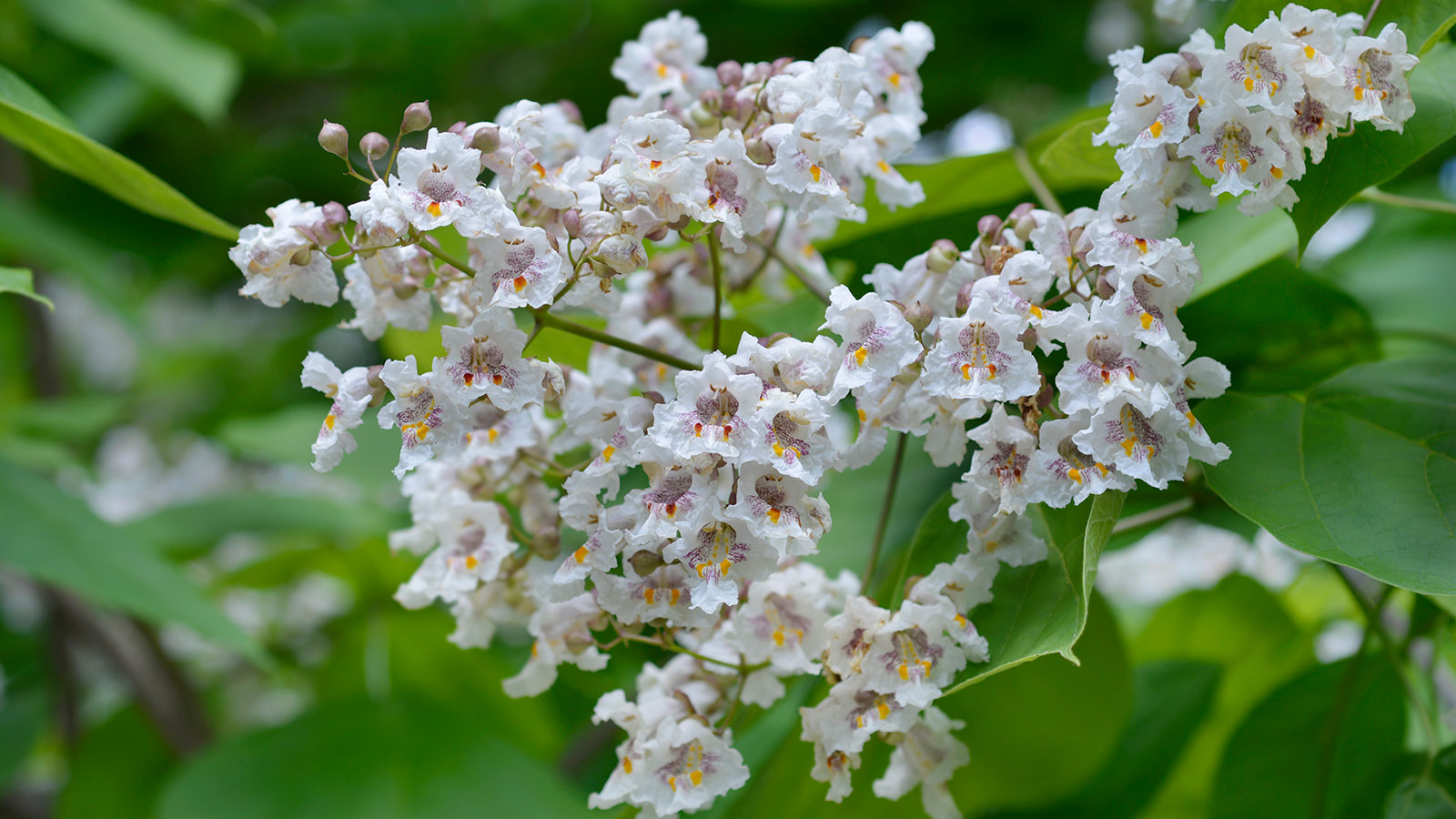

With its huge heart-shaped leaves, showy spring flowers and long seed pods, the catalpa tree adds serious wow factor to any backyard. It makes a lovely shade tree for the middle of a lawn, but it can also be hard pruned and used as an eye-catching foliage shrub within the borders. Despite its exotic appearance, catalpa is not difficult to grow.
There are approximately 10 species of catalpa found naturally in East Asia, the Caribbean, and the eastern and south-eastern US. Commonly known as the Indian bean tree, catalpa is not from the Indian sub-continent, nor does it produce edible beans. The ‘Indian’ part of the name refers to Native North Americans and it has been suggested that a European botanist named the tree after the tribe of Catawba, although he spelled the name ‘catalpa’ incorrectly.
Catalpa is among the most beautiful of all fast-growing flowering trees, and because its showy flowers appear from the end of May, it can act as a bridging plant between spring and summer-blooming trees. Its nectar-rich flowers are attractive to bees and other pollinators. When it comes to choosing the right catalpa for your backyard, first consider what space you have to grow one. The wild forms grow huge, while the cultivated varieties are much smaller. You can also restrict the size of the trees by using the horticultural pruning technique of pollarding.
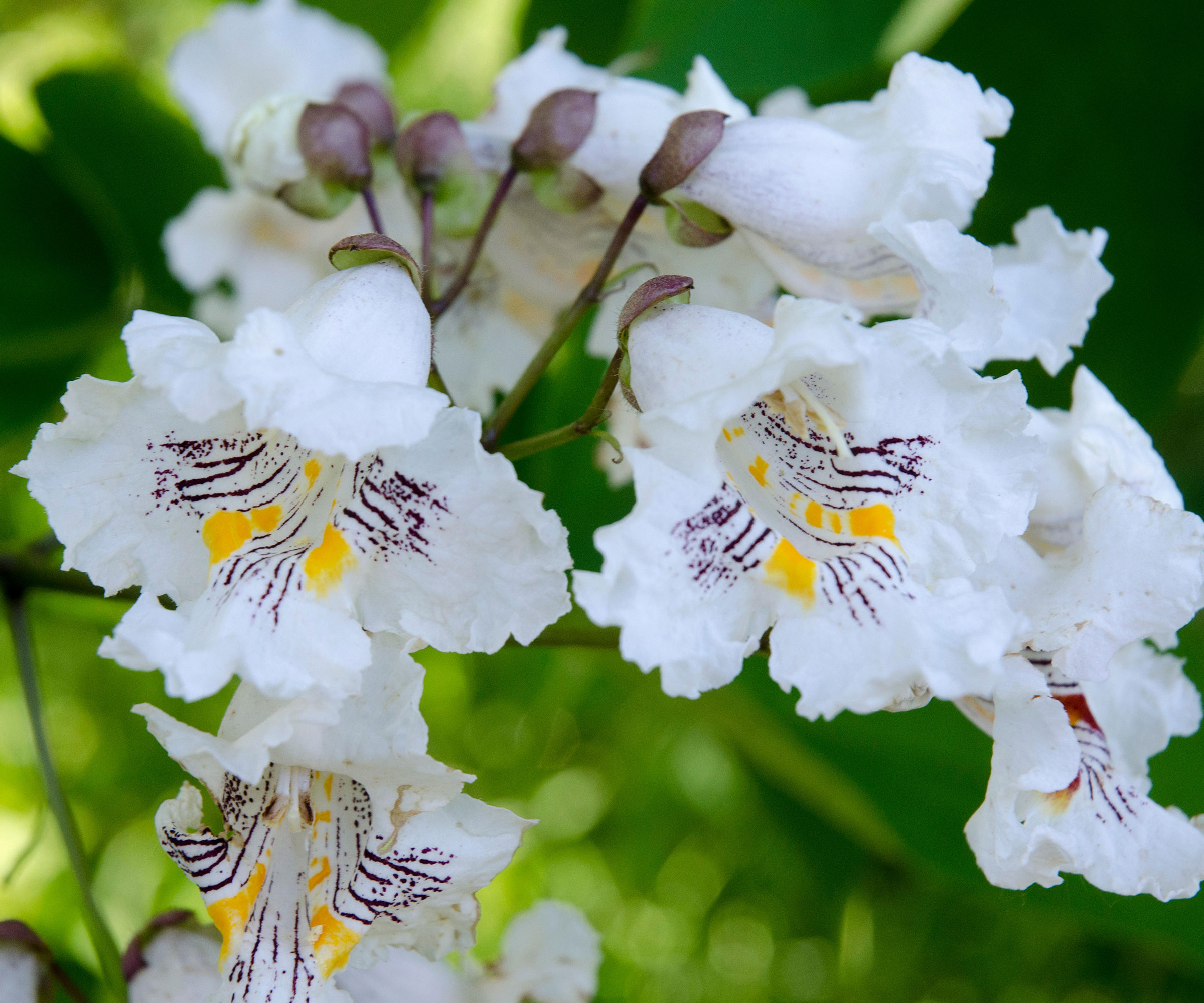
The large white flowers are a key attraction of the catalpa tree in late spring and early summer
Catalpa: key facts
- Plant type: Deciduous tree
- Mature size: Depending on the variety, from 6ft to over 39ft
- Soil type: Broad tolerance once established
- Soil PH: Acidic to neutral (5.5-7.0)
- Time of year to plant: Spring or fall
- Flowering time of year: Late spring/early summer
- Flower color: White with purple speckles, foxglove-like
- Hardiness zones: USDA 4-9, depending on species
- Scientific name: Catalpa
- Common name: Indian bean tree, cigar tree
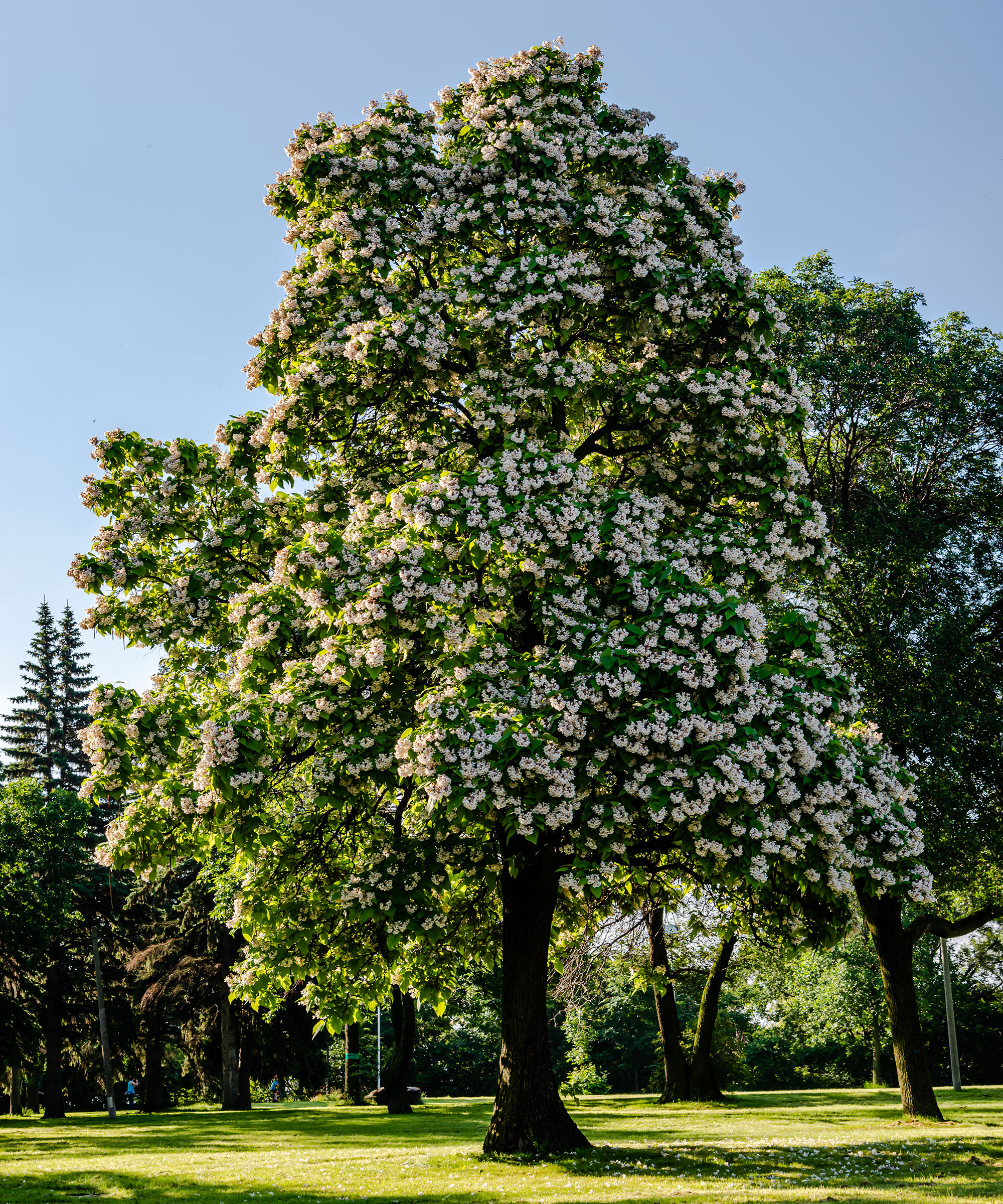
The Northern catalpa tree is suitable for USDA zones 4-8
Types of catalpa
- The wild forms of North American catalpa are C.speciosa and C.bignonoides. These both get very big when left unpruned and make great trees for shade in large backyards.
- For small backyards, C.bignonoides ‘Nana’ is the best choice, never getting any higher than 6ft. It’s usually grafted onto a tall-stemmed C.bignonoides rootstock and it rarely flowers. It can be easily pruned into a lollipop or umbrella shape.
- For mid-sized gardens, C.bignonoides ‘Aurea’ reaches 19ft-29ft high and 15-20ft wide. Its golden leaves are perfect for adding a splash of color. C. erubescens x ‘Purpurea’ has purple leaves in the spring that go greenish as they age, and it grows up to 32ft.
- C.speciosa, known as the northern catalpa is recommended for US Hardiness zones 4-8 by the United States Department of Agriculture and it can reach 40-60ft in 20 years. C.bignonoides is favored for zones 5-9 and it grows to 30-60ft.
On first glance, there doesn’t appear to be much difference between the two species but according to Treesandshrubsonline.org, C.speciosa grows taller and in a more upright shape, has more tapered leaves, and larger but fewer flowers. C.bignonoides has a neater, more spreading crown, and two smaller varieties have been developed from it.
Roger Davis, Landscape Manager at Longwood Gardens in Pennsylvania grows both: 'I would always tell people to consult with their local nurseries on availability and recommendations for their region,' he says.
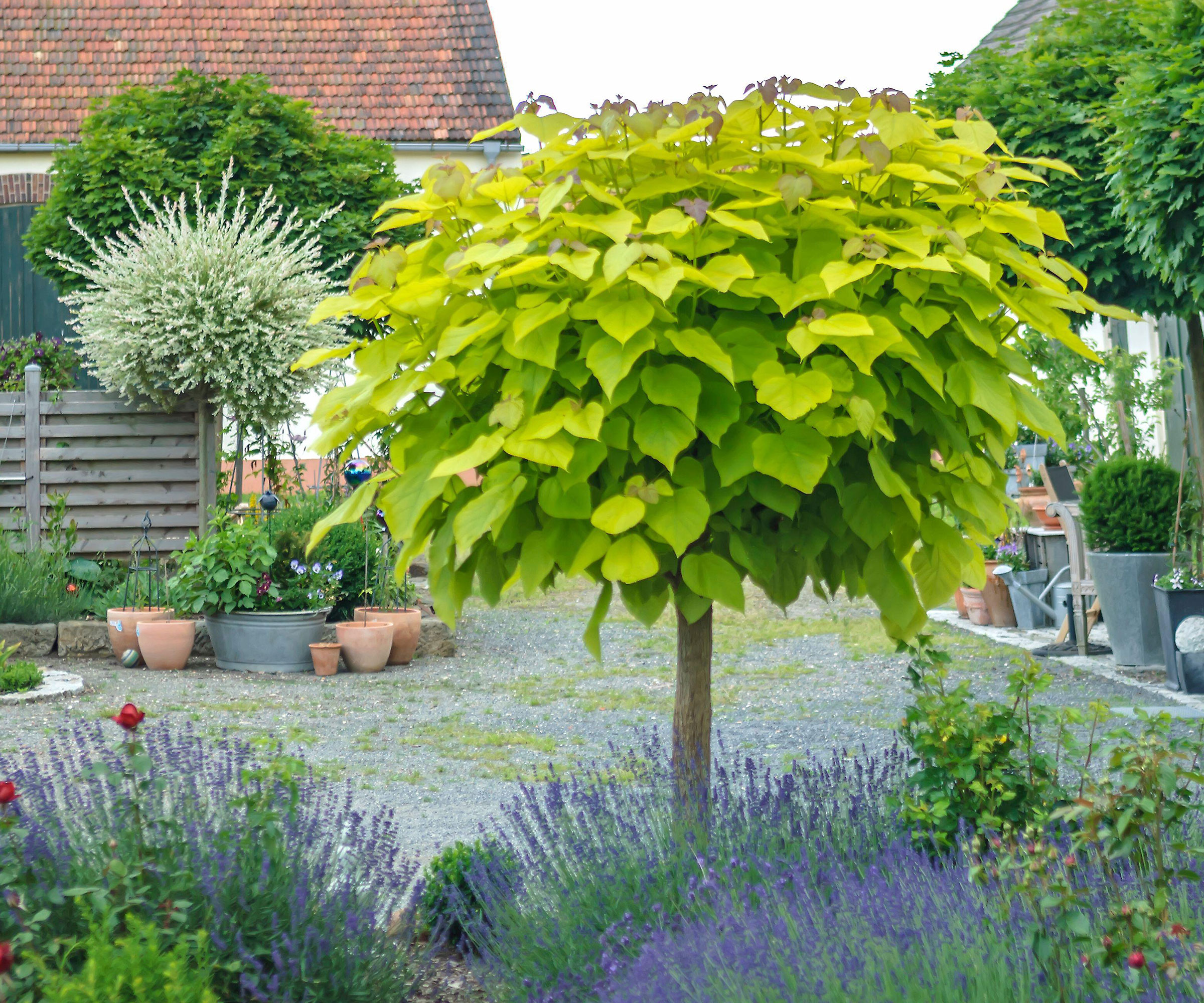
Catalpa bignonioides 'Aurea'
How to use catalpa in your yard
When grown as standalone specimen trees, catalpa has lots of wow-factor, but they’re fast-growing trees so watch for overhead wires. Despite its preference for moist soil, catalpa is considered a low water demand tree according to the Royal Horticultural Society, who recommend to plant low water uptake trees at a distance of half their eventual height from your house or other permanent structures like a pool.
You also need to consider the wide, round shape of catalpa’s canopy. If you’re planting C. ‘Aurea’ for example, a distance of 15-20ft from the house would be sensible.
Catalpa’s foliage offers bold contrast with other leaf shapes and flower colors. The zingy yellow leaves of C. ‘Aurea’ team up well with purple-flowered perennials like Salvia nemorosa and Allium ‘Globemaster’. Daisy flowers such as Rudbeckia and Leucathemum make lovely late summer companions.
Catalpa x eurubescens ‘Purpurea’ has purple-black young leaves in the spring that slowly turn dark green as they age. It works well with bright red dahlias and orange tagetes for an exotic look.
Pollarded – or ‘lollipop’ – catalpa can be used to create vertical focal points. They look stylish in modern backyards when used as part of a geometrical arrangement, in rows or a matrix. Give them space to see them at their best.
When regularly coppiced, catalpa can be grown in the borders where the beautiful, outsized foliage can be incorporated into a planting design. Miscanthus grass and sedum are good late season planting partners.
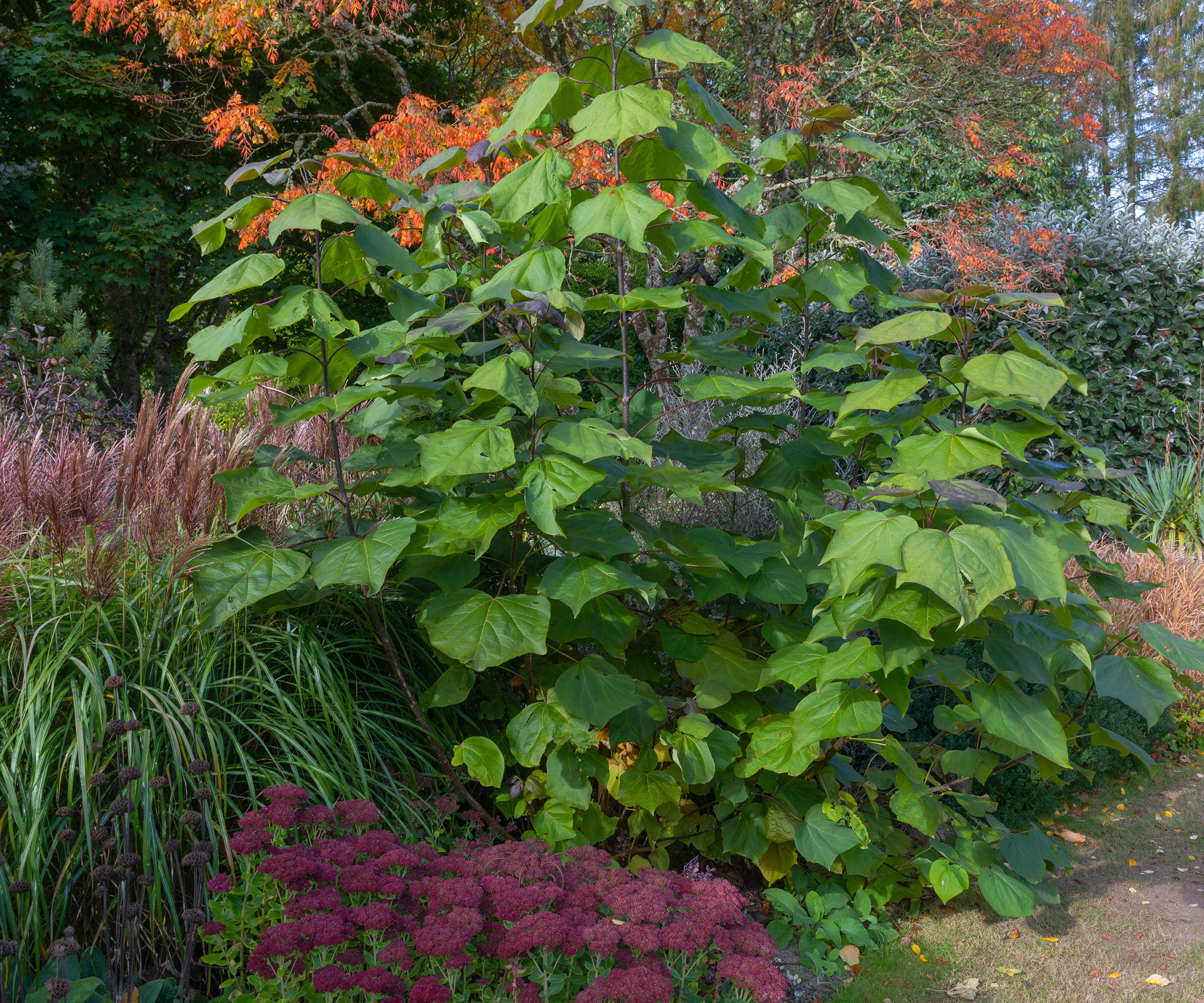
Catalpa x eurubescens ‘Purpurea’
When, where and how to plant catalpa
Spring or fall are the best times to plant catalpa, when the soil is warm and rainfall is higher. Pick a sunny spot, ideally somewhere that gets at least six hours of sunshine a day. Although catalpa is hardy, a late frost can affect the newly emerging foliage in spring and windy conditions may shred the leaves, so position the tree where it has some degree of shelter.
Catalpa thrives in deep moist, fertile ground but it is tolerant of most soil types. Regularly mulching with organic matter (like homemade compost or well-rotted manure) every spring will add nutrients to the soil, as well as help to lock in moisture.
When planting a tree like catalpa, dig a planting hole the same depth as the rootball and slightly wider. Carefully knock the plant out of its growing pot and place into the hole. Check the top of the rootball is level with the ground and backfill with the dug-out soil, tucking it into any gaps. Use your heel to gently push down the soil around the rootball.
Ensure the surrounding soil is free of weeds and other plants so your catalpa is not competing for moisture and nutrients while it’s establishing. Newly planted trees should be watered regularly, and fed with fertilizer in early spring as growth begins.
Catalpa’s natural habitat is in the east and southeast US, but according to the gardening community on Davesgarden.com, gardening folk are successfully growing this plant all over the US.
'For those in the warmer areas of the southwest, the related species chitalpa may be a better choice,' says Roger Davis, Landscape Manager at Longwood Gardens, Pennsylvania.
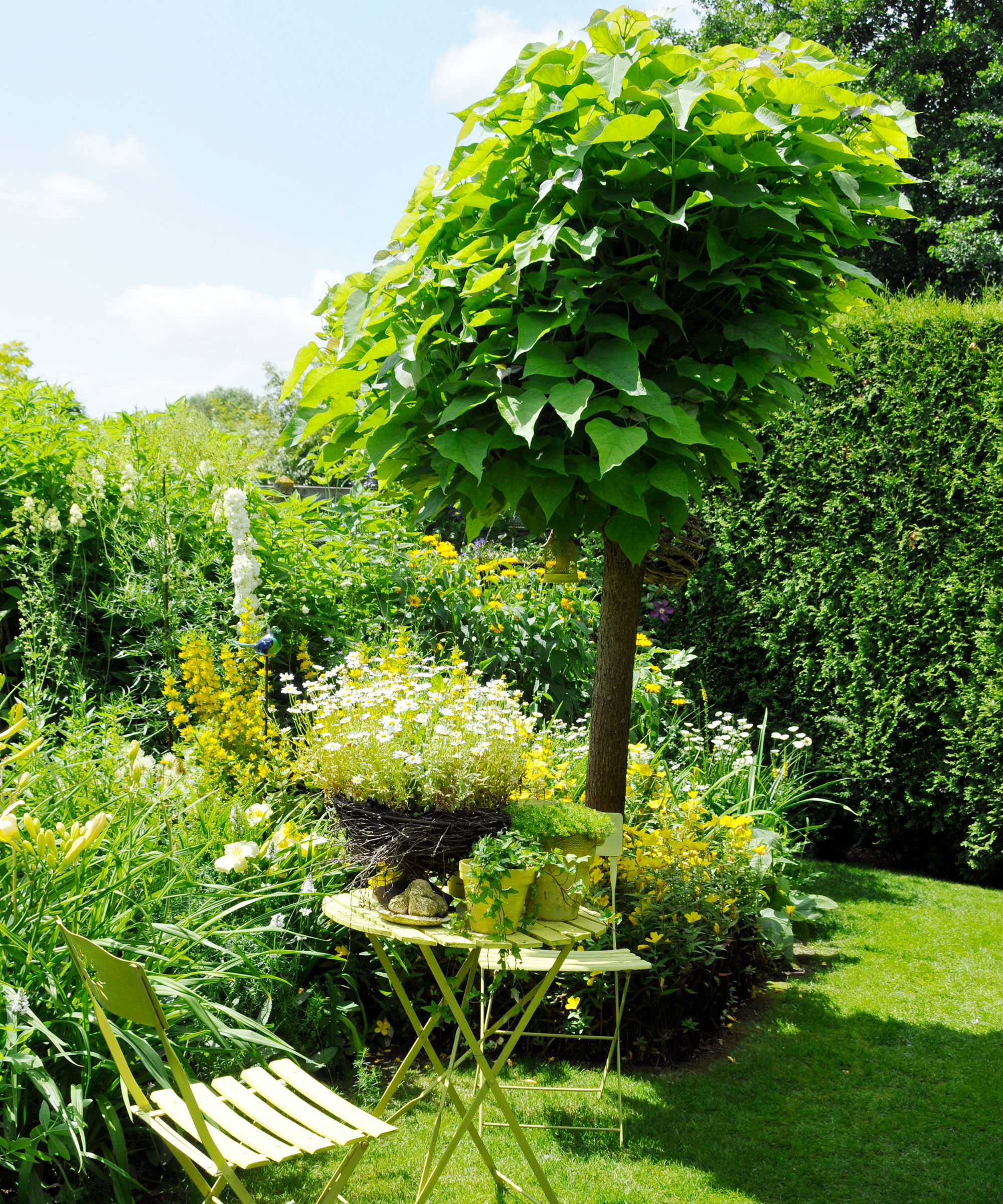
Catalpa trees can be grown in most regions of the US
Catalpa care tips
If you want keep catalpa’s size in check and prevent it from growing into a big tree (which is what it naturally wants to do) you’ll need to regularly coppice or pollard the branches. This is a gardening technique where all stems are cut back down to the ground or to a 5-6ft height trunk, every winter. It’s only a 10-minute job but it must be done regularly if you wish to retain catalpa at border-size. This technique will also encourage very large leaves (18in across).
Ensure you carry out pollarding and coppicing properly. Clean and sharpen pruning shears and tools to ensure your tools are properly disinfected, and make clean pruning cuts to avoid any fungal diseases entering the tree.
Catalpa trees have adapted to come into leaf later in order to avoid frost damage, so don’t be alarmed if yours doesn’t leaf until June.
How to make more catalpa
Catalpa can be propagated from fresh seed any time of year or from softwood cuttings in the summer. According to Treeseedonline.com 'the seeds first need to be soaked in water for 24 hours then drained and mixed with a little dry sand which helps to separate them from each other and make sowing them much easier.'
To sow the seeds, fill your seed tray or pot with a good-quality general potting compost. Firm the compost gently and sow the seeds on the surface – they must have light to enable germination. Give them a gentle watering. Cover the seeds with a transparent lid to increase humidity and keep them at room temperature.
Seeds will germinate, often erratically, over the next couple of weeks. Prick out the ones large enough to handle and pot them up into small pots. Grow the potted seedlings on out of direct sunlight, protecting them from frost for the first couple of winters. Harden off in spring and plant out.
Common problems and how to solve them
Catalpa drops a lot of leaf litter in the fall, along with any seed pods that aren’t still clinging to the tree. So be prepared to do some raking (although the large leaves are easy to gather), and you may need to pull up unwanted seedlings in the spring. You can put those fallen leaves to good use, however, by using them to make leaf mold in fall.
Towards the end of the summer, the foliage sometimes gets powdery mildew (white patches on the surface of the leaves) which can be treated with a fungicide but as the leaves will drop in the fall anyway, it’s probably easier to wait until that happens, gather them up and burn them safely.
Occasionally, an outbreak of ‘catalpa worms’ can defoliate trees in summer. Look on the leaves for caterpillars (the larvae of the sphinx moth) that are white-yellow with a black head and spine and that have a stiff ‘horn’ at the end of the abdomen.
'Healthy catalpa trees can withstand complete defoliation by catalpa worms and will often push out a second set of leaves if defoliation happens early in the season,' says PennState Extension. 'Repeated outbreaks of catalpa worms may damage and kill catalpa trees, especially trees that are already weakened by stress or disease. It may be best to remove and replace it with a different tree species altogether. If control is desired, pesticides that contain Bt (Bacillus thuringiensis) can be applied to the tree to kill the caterpillars when they are small.'
As with all plants, choose a spot with the correct growing conditions and get new catalpa specimens off to a good start, and hopefully you’ll have a strongly growing tree.

The green leaves of a catalpa bignonioides
FAQs
Is catalpa hardy?
Catalpa is hardy and can withstand temperatures as low as -20˚F. Northern catalpa (Catalpa speciosa) can survive down to -30˚F.
Can you plant catalpas in a shady spot?
Catalpa trees need a sunny, sheltered spot rather than one in shade. They are tolerant of most soils, but the ideal soil is well-drained and moisture-retentive.
Is catalpa native to North America?
There are approximately 10 species of catalpa and two of these – C.speciosa and C.bignonoides – are native to North America.
Catalpa are a fairly resilient and low-maintenance tree, making them a good option as a tree for front yards or backyards. By choosing the right variety to suit your region and the size of your space, you should find them relatively easy to care for. Regular pruning will help to keep their size in check.
Sign up to the Homes & Gardens newsletter
Design expertise in your inbox – from inspiring decorating ideas and beautiful celebrity homes to practical gardening advice and shopping round-ups.

Sally is horticulturally trained to degree level and has worked on gardening magazines for over a decade. She now regularly writes for Homes & Gardens and Easy Gardens. When Sally isn’t writing, she gardens for local clients, and cultivates her own little patch in sunny Bournemouth.
-
 Do cleaning products expire? Professional cleaners warn time could make them ‘less effective, and in some cases, irritating to use’
Do cleaning products expire? Professional cleaners warn time could make them ‘less effective, and in some cases, irritating to use’For the best results, it pays to stay on top of the timeline of your cleaning products
By Chiana Dickson Published
-
 7 of the best tomatoes for growing in pots - expert growers pick their top varieties ideal for large harvests from containers
7 of the best tomatoes for growing in pots - expert growers pick their top varieties ideal for large harvests from containersYou can enjoy bumper homegrown harvests in small spaces
By Drew Swainston Published